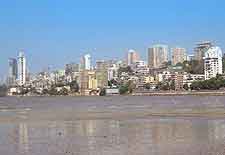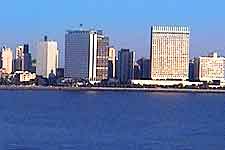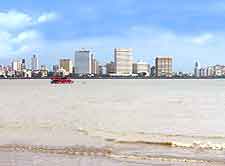Mumbai History Facts and Timeline
(Mumbai / Bombay, Maharashtra, India)

The massive conurbation of present-day Mumbai basks in over 2,500 years of history as a settlement, with this location being a haunt of Stone Age peoples for many millennia before that.
Set on seven islands, it first became the permanent home of the Kolis fisher community and developed into a spiritual centre for Hinduism and Buddhism by the 3rd century BC. Successive dynasties ruled the islands for the next 700 years, followed by the Silhara Dynasty until the late 14th century.
Islamic Domination
By 1347, the islands were under Islamic domination, initially by the Delhi sultanate and later by the Gujarat sultanate, with one of the city's most famous landmarks, the exquisite Haji Ali Dargah, built in 1431 as the tomb of Muslim saint Haji Ali. Sultanate patronage enabled the construction of a large number of Indian Islamic mosques and other buildings, all fine examples of the iconic architectural style - most of which are still standing today.

Mumbai Colonisation and the Raj
In 1508, Portuguese mariner and explorer Dom Francisco de Almeida arrived at the port, seeking to find more trading outlets for the valuable spices for which India was known. At this stage, it was named 'Good Bay' (Bom Bahia). By 1534, the islands were under Portuguese colonial rule and were later passed to the British crown in 1661, as part of Catherine of Braganza's dowry on her marriage to Charles II of England.
This convenient arrangement allowed the 1668 leasing of Mumbai to the East India Company and cemented the value of the colony as a major trading port, in spite of Mughal incursions during the last part of the 17th century. During the late 17th and 18th centuries, many fine colonial buildings and defensive structures, including St. Thomas Cathedral and Fort George, were constructed. Trade and shipbuilding continued under the company until well into the 19th century.
History of the 19th and 20th Centuries
Following the architectural achievements of the two previous centuries, economic development flowered in the early years of the 19th century, spurred to even greater heights by the arrival of the railway in 1853, linking the city with nearby Thane. Education progressed as well, leading to the city becoming the heart of the Indian independence struggle by the early 20th century. The Royal Indian Navy Mutiny took place here in 1946 and a year later, India's independence was declared.

Modern Times in Mumbai
As a result of Mumbai's 18th- and 19th-century history as a trading, commercial and manufacturing hub, the population of the city had swollen hugely as migrants from swathes of India's countryside arrived to find work. The islands were joined to the mainland and each other by causeways, and the city's university and major hospitals were founded.
The city's name was changed from its British Raj form, Bombay, to Mumbai in 1996. Nowadays, Mumbai's fascinating history, landmarks and monuments draw hundreds of thousands of visitors to this unique mega-city each year.
 The massive conurbation of present-day Mumbai basks in over 2,500 years of history as a settlement, with this location being a haunt of Stone Age peoples for many millennia before that.
The massive conurbation of present-day Mumbai basks in over 2,500 years of history as a settlement, with this location being a haunt of Stone Age peoples for many millennia before that.
